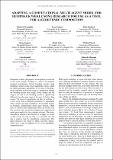Files in this item
Adapting a computational multi agent model for humpback whale song research for use as a tool for algorithmic composition
Item metadata
| dc.contributor.author | Mcloughlin, Michael | |
| dc.contributor.author | Ingram, Simon | |
| dc.contributor.author | Rendell, Luke Edward | |
| dc.contributor.author | Lamoni, Luca Ubaldo | |
| dc.contributor.author | Kirke, Alexis | |
| dc.contributor.author | Garland, Ellen Clare | |
| dc.contributor.author | Noad, Michael | |
| dc.contributor.author | Miranda, Eduardo | |
| dc.contributor.editor | Großmann, Rolf | |
| dc.contributor.editor | Hajdu, Georg | |
| dc.date.accessioned | 2016-11-10T10:30:29Z | |
| dc.date.available | 2016-11-10T10:30:29Z | |
| dc.date.issued | 2016-08-31 | |
| dc.identifier | 247542422 | |
| dc.identifier | 66f77a04-6920-4c73-b465-1140aa421e93 | |
| dc.identifier.citation | Mcloughlin , M , Ingram , S , Rendell , L E , Lamoni , L U , Kirke , A , Garland , E C , Noad , M & Miranda , E 2016 , Adapting a computational multi agent model for humpback whale song research for use as a tool for algorithmic composition . in R Großmann & G Hajdu (eds) , Proceedings SMC 2016 . Proceedings of the SMC Conferences , Hochschule für Musik und Theater Hamburg , pp. 274-280 , 13th Sound and Music Computing Conference and Summer School , Hamburg , Germany , 31/08/16 . | en |
| dc.identifier.citation | conference | en |
| dc.identifier.isbn | 9783000537004 | |
| dc.identifier.issn | 2518-3672 | |
| dc.identifier.other | ORCID: /0000-0002-8240-1267/work/49580210 | |
| dc.identifier.other | ORCID: /0000-0002-1121-9142/work/28052346 | |
| dc.identifier.uri | https://hdl.handle.net/10023/9795 | |
| dc.description.abstract | Humpback whales (Megaptera Novaengliae) present one of the most complex displays of cultural transmission amongst non-humans. During breeding seasons, male humpback whales create long, hierarchical songs, which are shared amongst a population. Every male in the population conforms to the same song in a population. During the breeding season these songs slowly change and the song at the end of the breeding season is significantly different from the song heard at the start of the breeding season. The song of a population can also be replaced, if a new song from a different population is introduced.This is known as song revolution. Our research focuses on building computational multi agent models, which seek to recreate these phenomena observed in the wild.Our research relies on methods inspired by computational multi agent models for the evolution of music. This interdisciplinary approach has allowed us to adapt our model so that it may be used not only as a scientific tool, but also a creative tool for algorithmic composition. This paper discusses the model in detail, and then demonstrates how it may be adapted for use as an algorithmic composition tool. | |
| dc.format.extent | 1160370 | |
| dc.language.iso | eng | |
| dc.publisher | Hochschule für Musik und Theater Hamburg | |
| dc.relation.ispartof | Proceedings SMC 2016 | en |
| dc.relation.ispartofseries | Proceedings of the SMC Conferences | en |
| dc.subject | QA75 Electronic computers. Computer science | en |
| dc.subject | QH301 Biology | en |
| dc.subject.lcc | QA75 | en |
| dc.subject.lcc | QH301 | en |
| dc.title | Adapting a computational multi agent model for humpback whale song research for use as a tool for algorithmic composition | en |
| dc.type | Conference item | en |
| dc.contributor.sponsor | The Leverhulme Trust | en |
| dc.contributor.institution | University of St Andrews. School of Biology | en |
| dc.contributor.institution | University of St Andrews. Centre for Social Learning & Cognitive Evolution | en |
| dc.contributor.institution | University of St Andrews. Sea Mammal Research Unit | en |
| dc.contributor.institution | University of St Andrews. Marine Alliance for Science & Technology Scotland | en |
| dc.contributor.institution | University of St Andrews. Bioacoustics group | en |
| dc.contributor.institution | University of St Andrews. Centre for Biological Diversity | en |
| dc.identifier.url | http://quintetnet.hfmt-hamburg.de/SMC2016/wp-content/uploads/2016/09/SMC2016_proceedings_final.pdf | en |
| dc.identifier.grantnumber | en |
This item appears in the following Collection(s)
Items in the St Andrews Research Repository are protected by copyright, with all rights reserved, unless otherwise indicated.

